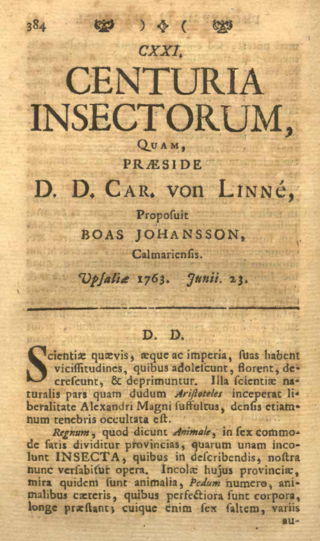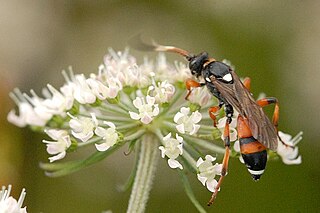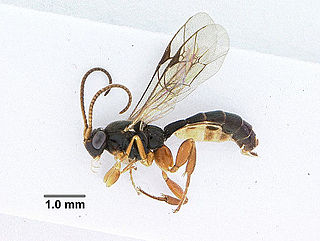
Johann Reinhold Forster was a German Reformed (Calvinist) pastor and naturalist who made contributions to the early ornithology of Europe and North America. He is best known as the naturalist on James Cook's second Pacific voyage, where he was accompanied by his son Georg Forster. These expeditions promoted the career of Johann Reinhold Forster and the findings became the bedrock of colonial professionalism and helped set the stage for the future development of anthropology and ethnology. They also laid the framework for general concern about the impact that alteration of the physical environment for European economic expansion would have on exotic societies.

The superfamily Ichneumonoidea contains one extinct and three extant families, including the two largest families within Hymenoptera: Ichneumonidae and Braconidae. The group is thought to contain as many as 100,000 species, many of which have not yet been described. Like other parasitoid wasps, they were long placed in the "Parasitica", variously considered as an infraorder or an unranked clade, now known to be paraphyletic.

The Ichneumonidae, also known as ichneumon wasps, ichneumonid wasps, ichneumonids, or Darwin wasps, are a family of parasitoid wasps of the insect order Hymenoptera. They are one of the most diverse groups within the Hymenoptera with roughly 25,000 species described as of 2016. However, this likely represents less than a quarter of their true richness as reliable estimates are lacking, along with much of the most basic knowledge about their ecology, distribution, and evolution. It is estimated that there are more species in this family than there are species of birds and mammals combined. Ichneumonid wasps, with very few exceptions, attack the immature stages of holometabolous insects and spiders, eventually killing their hosts. They thus fulfill an important role as regulators of insect populations, both in natural and semi-natural systems, making them promising agents for biological control.

Banchinae is a subfamily of ichneumonid parasitoid wasps containing about 1,500 species; the genera Glypta and Lissonota are very large. The three tribes are all distributed worldwide.

Chrysolina hyperici, the Saint John's wort beetle is a species of beetles of the family Chrysomelidae.

Cryptostylis, commonly known as tongue orchids, is a genus of flowering plants from the orchid family. Tongue orchids are terrestrial herbs with one to a few stalked leaves at the base of the flowering stem, or leafless. One to a few dull coloured flowers are borne on an erect flowering stem. The most conspicuous part of the flower is the labellum, compared to the much reduced sepals and petals. At least some species are pollinated by wasps when they attempt to mate with the flower. There are about twenty five species found in South Asia, Southeast Asia and the South Pacific.

Centuria Insectorum is a 1763 taxonomic work by Carl Linnaeus, and defended as a thesis by Boas Johansson; which of the two men should for taxonomic purposes be credited with its authorship has been the subject of some controversy. It includes descriptions of 102 new insect and crustacean species that had been sent to Linnaeus from British America, Suriname, Java and other locations. Most of the new names included in Centuria Insectorum are still in use, although a few have been sunk into synonymy, and one was the result of a hoax: a common brimstone butterfly with spots painted on was described as the new "species" Papilio ecclipsis.

Beris vallata, the orange legionnaire or common orange legionnaire, is a European species of soldier fly.

Beris chalybata, the murky-legged black legionnaire, is a European species of soldier fly.

Beris is a genus of flies in the family Stratiomyidae. They are also referred to as the false soldier fly. As described by Latreille in 1802, these are small to medium sized flies with metallic colors.

Amblyteles armatorius is a species of parasitic wasp in the family Ichneumonidae first described by Johann Reinhold Forster in 1771.

Ichneumon sarcitorius is a species of wasp belonging to the family Ichneumonidae subfamily Ichneumoninae.

Megarhyssa macrurus, also known as the long-tailed giant ichneumonid wasp or long-tailed giant ichneumon wasp, is a species of large ichneumon wasp. It is a parasitoid, notable for its extremely long ovipositor which it uses to deposit an egg into a tunnel in dead wood bored by its host, the larva of a similarly large species of horntail.

Nysson spinosus, the large-spurred digger wasp, is a species of cleptoparasitic wasp of the family Bembicidae which is found in the Palearctic.

Parethelcus pollinarius is a species of weevil native to Europe.

Tabanus americanus, the American horse fly, is a species of horse-fly in the family Tabanidae.

Trogus is a genus of parasitoid wasp found in the Holarctic and Neotropic regions. It is placed in the subfamily Ichneumoninae and the tribe Ichneumonini. Trogus species are parasites of larvae and pupae of the swallowtail butterfly family, Papilionidae. The genus consists of twelve extant and one extinct species.

Orthocentrinae is a subfamily of ichneumon wasps in the family Ichneumonidae. There are at least 29 genera in Orthocentrinae.

Diplazon laetatorius is a hover fly parasitoid wasp in the Diplazontinae subfamily of the Ichneumonid wasp family (Ichneumonidae) It was first described as Ichneumon laetatorius in 1781 by Johan Christian Fabricius.

Ichneumon centrator, the centrator wasp, is a species of endoparasitic parasitoid wasp belonging to the family Ichneumonidae in the subfamily Ichneumoninae. It was first described by Thomas Say in 1825 and is native to North America.



















